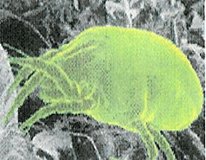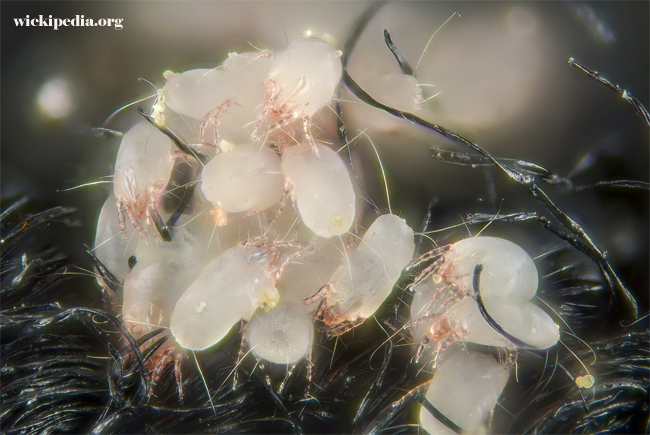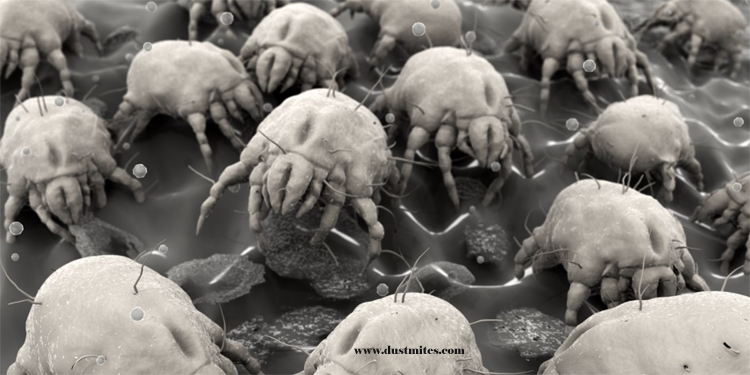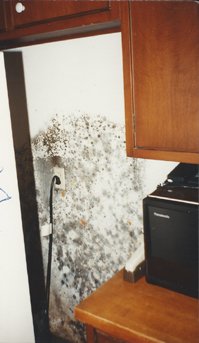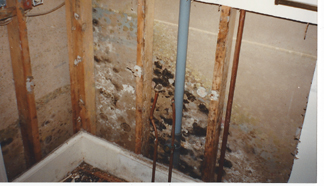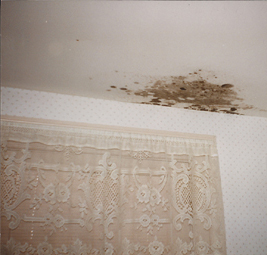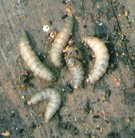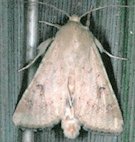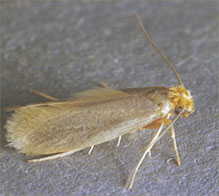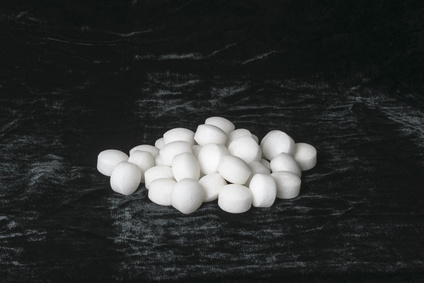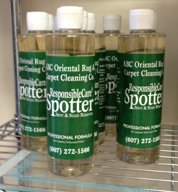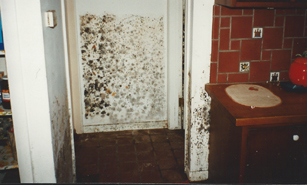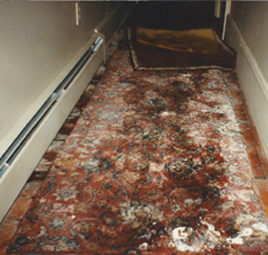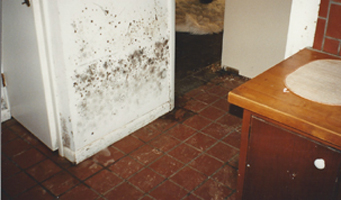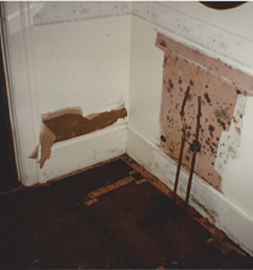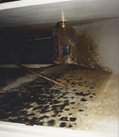HOME HEALTH HAZARDS
and
What to Do About Them
The dangers from some home health hazards such as food, fire, and carbon monoxide poisoning have been pretty well publicized but there are many others that can creep up on you and cause you harm because they are not as noticeable at first.
We will review 3 of these in this article. They are dust mites, mold, and moths.
DUST MITES
Dust mites are top home health hazards, especially because you can't see them with the naked eye. Yet they can be one of the most common causes of asthma and allergies.
WHAT THEY LOOK LIKE
Dust mites are microscopic, eight-legged creatures that are 0.3mm in length (7,000 can fit on a fingernail) and are invisible to the naked eye.
A male dust mite has an average life cycle of 10 to 19 days, while a mated female dust mite can last as much as 70 days. She may lay 60 to 100 eggs in the last 5 weeks of her life alone.
WHERE THEY CAN BE FOUND
Dust mites can survive in any climate. They especially love the bedrooms and kitchens of our homes. Because they need moisture to live and they feed off the dead skin cells our bodies shed, their favorite hiding places are mattresses, sheets and pillows. In dry climates, the mites survive by deriving moisture from the humidity generated by human breathing, perspiration and saliva.
THE DUST MITE FECES CAUSE THE ALLERGY SYMPTOMS
It is the dust mite feces that is the main cause of the development and aggravation of allergies. A dust mite will produce 200 times its own body weight in feces during its short lifetime!
Itchiness, sneezing, inflamed or infected eczema, watering/reddening eyes, sneezing repeatedly and frequently, runny nose, and clogging in the lungs are typical symptoms of dust mite allergy sufferers.
TIPS FOR LIVING WITH DUST MITES
There is no way to permanently get rid of dust mites. The only answer is to put a barrier between you and them.
Here are some tips:
- Use allergy covers that can be found wherever sheets are sold. These are woven so dust mites can't slip through them.
- If you suspect dust mite allergies, wash items such as your bedding in hot water (120 degrees F) at least once a week.
- Items that are not machine-washable, ex. stuffed animals, put in a freezer for at few hours at a time to kill the dust mites.
- Never go to bed with wet hair. This will make your bed even more susceptible to those moisture-loving dust mites.
- Make sure to vacuum floors and carpets regularly, as this is where dust mites can hide.
Should you need help with a dust mite problem, please call our office at 607-272-1566. For your carpets, rugs, and upholstery, we offer our very effective dust mite treatment.
Studies by doctors and universities have demonstrated that when dust mite droppings are treated with the main active ingredient contained in our dust mite anti-allergen treatment, the allergens are physically changed, rendering them permanently harmless to people who display allergic symptoms to dust mite allergens.
For more in-depth information on dust mites, please read our article here.
MOLD
Mold (as well as the type of mold known as mildew) is a form of fungus and is one of the top home health hazards. After a flood occurs, the removal of the resultant mold is a priority. Mold is fast-growing and the mold spores it produces will travel wherever there is moisture and a food source. It is very attracted to building materials such as drywall as well, and can start its damage behind the walls before you notice it.
The ability to exist on just about any type of material (as long as there is organic material on it) gives these micro-organisms the dubious distinction of being called the chief agents of deterioration. Regardless of the particular organic material that may be present, neither mold nor mildew can resist surfaces where there is moisture. They both prosper in dark, humid, damp, and poorly ventilated environments.
It may surprise you to know that mold and mildew are invisible and odorless! What are those black, green, yellow, etc. spots then? And what about that moldy odor? What you are actually seeing and smelling is the end result of the digestive process of these micro-organisms as they eat through your organic possessions.
The mold spores can trigger asthma symptoms, such as coughing, wheezing, and shortness of breath, as well as sneezing, runny or stuffy nose, itchy, watery eyes, and inflamed sinuses. They can also cause serious fatigue.
MOLD PREVENTION TIPS
Spore growth needs moisture, high temperature, high humidity, and a food source to grow. Removing any of these four factors will also deter their growth.
- Stop any water intrusion from leaky pipes, non water-resistant building materials, rain water, etc.
- Clean fabrics often and keep them in well-ventilated area.
- Reduce moisture with dehumidifiers and open windows or use air conditioners (in hot weather) with the goal of keeping the relative humidity in your home environment below 50%.
- Check regularly in problem areas such as bathrooms or laundry rooms for moldy–smelling odors.
- Cover any dirt floors in basements with plastic in order to slow down the water vapor that comes through the soil.
- Make sure your kitchen and baths have ventilation fans and periodically check to make sure they are venting to the outside and that they have not become disconnected or blocked.
- Dryer vents can be a real problem. Make sure they are attached securely to the dryer and are venting to the outside. The vent duct can accumulate lint and should be cleaned at least once a year and checked for any holes that might leak air.
- Have your heating and cooling system in your home checked to make sure it is the correct size and that it is working properly to remove humidity. Also check your duct system for any air leaks.
STEPS TO TAKE IF YOU FIND MOLD GROWTH IN YOUR HOME
- Take out anything that has mold or mildew on it.
- Kill any remaining mold or mildew with a mildicide.
- Vacuum everything.
- Replace cardboard containers with plastic bins but make sure to position small boards on shelves under the bins in order to allow for continued air flow.
- You may want to spray walls with a commercial sprayer containing 10% sodium hypochlorite (bleach).
Unfortunately, none of these actions will kill the spores so continuous monitoring of these areas is still necessary.
WHAT IF YOU HAVE HAD A FLOOD IN YOUR HOME?
Floods are a major cause of mold and mildew growth. Mold and mildew will begin to develop within 24 to 48 hours of any water exposure in the home. Mold and mildew will continue to grow until the source of the moisture is dealt with. For detailed information on what steps to take as soon as a flood occurs, please click here.
If you suspect a mold problem, please call our office at 607-272-1566. Although we no longer offer flood or mold remediation services, we would be happy to answer any questions and help you in any way we can.
If the water damage occurs on an area rug from a flood, spill, urine, over watering of plant pot, etc., it is important to get it treated as soon as possible because the mold can cause permanent damage. Again, please call our office at 607-272-1566 for more information or to schedule a pick up. We may also be able to repair any damage for you.
Other articles on our website about mold and mildew include Mold and Mildew, Mold or Mildew, and Prevent Mold and Mildew.
MOTHS
The presence of moths in the home would probably not correctly be considered home health hazards. That is, unless you consider the emotional stress caused by the permanent moth damage to your grandmother's valuable oriental rug or the severe home health hazards that can be caused by the use of mothballs!
HOW DOES THE DAMAGE FROM MOTHS HAPPEN?
It is not the moth itself but the larvae of the moth that cause the damage. The life cycle of the moth can last from 2 months to 2 ½ years. The adults lay eggs on products that the larvae will consume. Each female can lay from 100 to 150 eggs which hatch in about 5 days. The small white caterpillars vary in size from 1/16" newly hatched to 1/3" fully grown.
The larval stage itself can last from 2 to 30 months. The reason for this great variance in the life cycle is dependent on the availability of food. If gone unnoticed, the larvae on a wool rug can feed for almost 2 ½ years. An infestation of only several weeks can result in pile loss the size of a fist.
The moth larvae can feed on a mixture of natural and synthetic fabrics. They cannot, however, feed on materials made entirely of synthetic fibers. But if the synthetic fibers have pollen, hair, dead insects or dried animal remains on them, they will hide and feed on items with synthetic fibers as well.
Moth larvae thrive in dark, undisturbed areas where a rug or carpet gets little traffic and is not often vacuumed, especially such as a rug or carpet under furniture. They are particularly attracted to the keratin in animal hair. The wool alone in an oriental rug is susceptible, but just imagine a dirty rug covered in dog and cat hair. That would be like a smorgasbord to this creature!
HOW DO YOU KNOW IF YOU HAVE A MOTH PROBLEM?
Be on the lookout for the following:
- Flying Adults Moths.
- Loose carpet or rug fibers resting on top of the pile. This means the larvae have actually eaten the knots off the foundation of the rug.
- Cocoons, approximately 1/8 inch diameter x ½ inch long. They will be lightly fuzzy cylinders, usually the same color as the pile of the rug. Larvae camouflage their cocoons to blend in with the color of the wool that surrounds them.
- The actual larvae squirming along the pile surface and underneath the rug.
WHAT TO DO IF YOU HAVE FOUND EVIDENCE OF a MOTH INFESTATION?
If you find moth larvae or signs of moth damage in your area rugs, carpets, or upholstery, a thorough decontamination and cleaning procedure such as the one we have at ABC is the best way to prevent further damage. Our experienced Rug Repair Technicians can patch or reweave the areas of rugs that have been damaged.
Unfortunately, this does not address the possibility that larvae may move from one rug or one area to another. What this means is that it is necessary to find and kill not only the adults but their larvae and their eggs even before the infected rug is cleaned.
For a severe infestation, it may be necessary to call in a licensed pest control operator if the infestation is severe.
CAUTION: DO NOT USE MOTHBALLS FOR EITHER PREVENTION OR TREATMENT OF A MOTH PROBLEM!
- The compounds (paradicholorobenzene or naphthalene) used in mothballs are ineffective in control of these insects for rugs and other furnishings. (Cedar scent is also useless.) These materials act only as a minor repellent. They do not kill the larvae or eggs, and the naphthalene odor can be unpleasant and extremely difficult to remove.
- Mothballs can be especially dangerous if accidentally eaten, especially by young children. In general, it is recommended mothballs should not be used by homeowners under any circumstances. If they continue to be used, they should only be used in small amounts and items around them should be thoroughly cleaned.
- The ingredients in mothballs can produce harmful effects when they enter your system through inhalation. Irritation to nose, throat and lungs, headache, confusion, excitement or depression and liver and kidney damage can result from exposure to the vapors over a long period of time.
- The little white balls that contain naphthalene are of special concern because naphthalene can promote a breakdown of red blood cells resulting in hemolytic anemia. Hemolytic anemia in mild form may cause only fatigue. In more severe cases, it can cause acute kidney failure.
- Of course, only high concentrations of these ingredients can cause any of these effects. Such concentrations are found when vapors are absorbed by clothes or rugs that are stored or kept in closed areas with poor ventilation.
- Poisonings have been reported following dressing of infants in clothing that was stored with naphthalene mothballs, suggesting that absorption of naphthalene may occur through the skin.
- Moth balls should be taken to a licensed hazardous waste handler to be disposed of or saved for a professional household hazardous waste collection program.
HOW TO PREVENT A MOTH INFESTATION
The best way to prevent an infestation is periodic inspection of rugs, whether stored or not, as well as the carpets and wool, silk, and cotton textiles in your home. Be sure to check underneath furniture and behind wall hangings as well.
Of course, it goes without saying that keeping your rugs, carpets, upholstery and other moth-susceptible textiles cleaned on a regular basis is very important to the prevention of moths.
At ABC, we are always concerned about moths for our customers and our cleaning of wool rugs includes a final rinse which rends the wool unappetizing to these creatures. This 'retardant' feature, combined with a thoroughly cleaned rug will almost completely guarantee prevention of damage during storage.
At the first sign of a problem, please call our office at 272-1566 if you have any questions about moths. You may also contact us by clicking here. We are prepared to help you in any way we can.
Other articles about moths on this website include About Moths, More About Moths, Moths in Area Rugs and Carpets, and Moths in Your Rugs.
"The Cleanest Clean You've Ever Seen."
by
ABC Oriental Rug & Carpet Cleaning Co.
130 Cecil Malone Drive Ithaca, NY 14850
607-272-1566
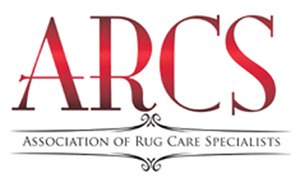
ABC Oriental Rug & Carpet Cleaning Co.
is a FOUNDING MEMBER of the
Association
of Rug Care Specialists.
"To Teach, Cultivate and Advance the Art and Science
of Rug Care"

Give the Gift of ABC CLEAN!
Gift Certificates Make Great Gifts!
Call Today
607-272-1566
or
Stop In to Order

ABC
Carpet & Rug
Spotting Guide
ABC
Carpet & Rug
Spotting Guide
Learn how to remove spots with ordinary household solutions
Sign up below to gain access to your complementary Spotting Guide from ABC.
Registering your email address guarantees you will be notified whenever discount savings coupons become available.
Did you know that our ABC Responsible Care Spotter can get those pesky spots out of your carpet and rugs and will work equally as well on your clothes and upholstery?
Stop by our office and pick one up. They are $5.00 + Tax but if you have carpets or upholstery cleaned in your home or business, just request a free one from your Technician.
And don't forget to fill out the form above to download your free ABC Spotting Guide!
